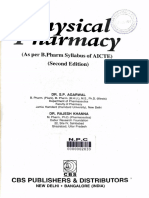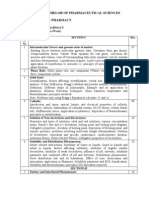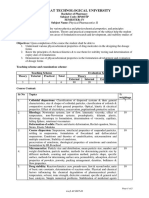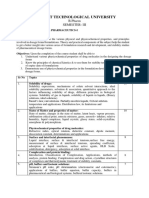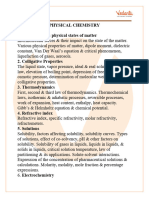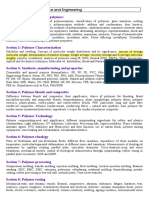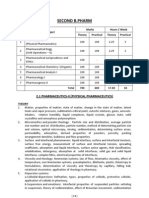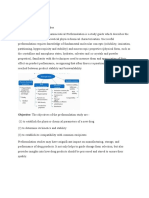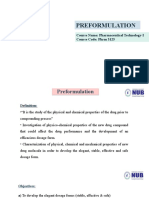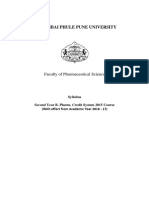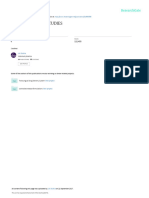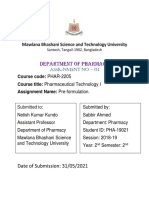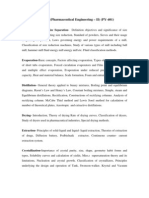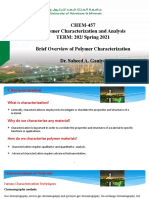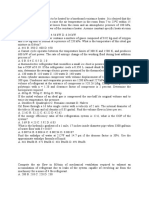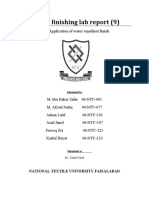Second B. Pharm. Ph202 Pharmaceutics-Iii (Physical Pharmacy) Theory 3hrs/week
Second B. Pharm. Ph202 Pharmaceutics-Iii (Physical Pharmacy) Theory 3hrs/week
Uploaded by
moiht007spsCopyright:
Available Formats
Second B. Pharm. Ph202 Pharmaceutics-Iii (Physical Pharmacy) Theory 3hrs/week
Second B. Pharm. Ph202 Pharmaceutics-Iii (Physical Pharmacy) Theory 3hrs/week
Uploaded by
moiht007spsOriginal Description:
Original Title
Copyright
Available Formats
Share this document
Did you find this document useful?
Is this content inappropriate?
Copyright:
Available Formats
Second B. Pharm. Ph202 Pharmaceutics-Iii (Physical Pharmacy) Theory 3hrs/week
Second B. Pharm. Ph202 Pharmaceutics-Iii (Physical Pharmacy) Theory 3hrs/week
Uploaded by
moiht007spsCopyright:
Available Formats
SECOND B. PHARM. PH202 PHARMACEUTICS-III (PHYSICAL PHARMACY) Theory 3hrs/week 1.
Matter, properties of matter: Binding forces between molecules, State of matter, gaseous, liquid, liquefaction of gases, liquefaction, aerosols, Change in state of matter, latent heats and vapor pressure, sublimation-critical point, eutectic mixtures, gases, aerosols inhalers, relative humidity, liquid complexes, liquid crystals, glassy state, solid crystalline and amorphous, polymorphism. System containing one, two and three components. 2. Micromeritics and powder rheology: Introduction and significance, Particle size and distribution, average particle size, number and weight distribution, particle number, methods of determining area, permeability, adsorption, derived properties of powders, porosity, packing arrangement densities, bulkiness and flow properties, rheological parameter of powders. 3. Compaction, Compression, Consolidation and Granulation of powdered solids 4. Solutions of nonelectrolytes and electrolytes: Types of solutions, True, ideal and real solutions, Properties of solutions, lowering of vapor pressure, determination of v. p., depression of F.P., determination of F. P. lowering, elevation of B.P., determination of B.P. elevation, 5. Surface and interfacial phenomenon: Liquid interface, surface and interfacial tensions, surface free energy, measurement of surface and interfacial tensions, spreading coefficient, adsorption at liquid interfaces, surface active agents, HLB classification, solubilization, detergency, adsorption at solid interfaces, solid gas and solid liquid interfaces, complex film, electrical properties of interface. 6. Viscosity and Rheology: Newtonian systems, law of flow, kinematic viscosity, effect of temperature, Non-Newtonian systems, pseudoplastic, dilatant, plastic, thixotropy measurement and applications in formulation, determination of viscosity by capillary, falling ball, rotational viscometers, Brookfield viscometer, applications of rheology in pharmacy. 7. Dispersion systems: (a) Colloidal Dispersions: Definition types, properties of colloids, protective colloids, application of colloids in pharmacy.(b) Suspension and emulsions: Interfacial properties of suspended particles, settling in suspensions, theory of sedimentation, effect of Brownian movement, sedimentation of flocculated particles, sedimentation parameters, wetting of particles, control flocculation, flocculation in structured vehicles, rheological considerations, emulsions, types, theories, physical stability. 8. Complexation: Classification of complexes, methods of preparation and analysis, applications, protein binding. 9. Kinetics: Rates and orders of reaction, determination of order, Influence of temperature and other factors on reaction rates, decomposition and stabilization of medicinal agents, kinetics in solid state, accelerated stability study, expiration dating. 10. Buffer equations and buffer capacity in general, buffer in pharmaceutical systems, preparations, stability, buffered isotonic solutions, measurements of tonicity calculations and methods of adjusting isotonicity.
Practical
PH202 PHARMACEUTICS-III (PHYSICAL PHARMACY) 3hrs/week
1. Determination of latent heat, vapor pressure, critical point. 2. Studies on polymorphs, their identification and properties. 3. Determination of particle size, particle size distribution and surface areas using various methods of particle size analysis. 4. Determination of derived properties of powders: density, porosity, compressibility, angle of repose etc. 5. Determination of surface/interfacial tension, HLB value and critical micellar concentration of surfactants. 6. Study of rheological properties of various types of systems using different Viscometers. 7. Studies of different types of colloids and their properties. 8. Preparation of various types of suspensions and determination of their sedimentation parameters. 9. Preparation and stability studies of emulsions. 10. Studies on different types of complexes and determination of their stability constants. 11. Preparation of pharmaceutical buffers and determination of buffer capacity. 12. Preparation involving tonicity adjustments. 13. Determination of C.S.T and partial or mutual solubility. 14. Determination of C.M.C of surfactant. 15. Determination of isoelectric point, blooming rating of proteins and gelatin. 16. Study of measurement of molecular weight of polymers macromolecular substances. 17. Temp. Dependency and viscosity study of binary systems. List of Books 1.Physical pharmacy by Alfred Martin. Fourth Edition. 2.Pharmaceutics: The science of dosage form design edited by M.E. Aulton (1998). 3.Remington: The science and practice of pharmacy, 19th edition, Volume I and II. 4.Pharmaceutical Dosage forms and drug delivery systems by Ansel, Popovich and Allen. Sixth Edition.
You might also like
- Khanna & Agarwal Physical PharmacyDocument332 pagesKhanna & Agarwal Physical PharmacyMohith KothariNo ratings yet
- Smith6e Chapter25 TB AnswerKeyDocument29 pagesSmith6e Chapter25 TB AnswerKeyandrew.gregory978No ratings yet
- Ch16 HW08 SIM KeyDocument9 pagesCh16 HW08 SIM KeyJ100% (2)
- Polymer Rheology. Theory and Practice - Yuri G. YanovskyDocument308 pagesPolymer Rheology. Theory and Practice - Yuri G. YanovskyJose RdzNo ratings yet
- Student Practice Questions For Chemical Engineering Calculations For CombustionDocument6 pagesStudent Practice Questions For Chemical Engineering Calculations For CombustionDonPedrew60% (5)
- 1 Physical Pharmacy (2220001)Document2 pages1 Physical Pharmacy (2220001)vanitaNo ratings yet
- GPAT Physical Pharmacy SyllabusDocument2 pagesGPAT Physical Pharmacy Syllabuskumar Harsh100% (1)
- Second Year B Pharmacy SyllabusDocument22 pagesSecond Year B Pharmacy SyllabusSidhharrth S KumaarNo ratings yet
- BP403TPDocument2 pagesBP403TPRadhika JasaniNo ratings yet
- BP302TPDocument2 pagesBP302TPShrinidhi AcharyaNo ratings yet
- BP403TP MergedDocument12 pagesBP403TP Mergedparmarkomal1416No ratings yet
- GPAT Syllabus 2023-24 PDF DownloadDocument120 pagesGPAT Syllabus 2023-24 PDF DownloadAjay BhoyeNo ratings yet
- Polymer Science SyllabusDocument2 pagesPolymer Science Syllabus2K18PS045 Sumit ChaudharyNo ratings yet
- 5th Sem SyllabusDocument5 pages5th Sem SyllabusGaurav BitNo ratings yet
- GPAT-Entrance-Exam-2023-SyllabusDocument64 pagesGPAT-Entrance-Exam-2023-Syllabuskrishna munjaleNo ratings yet
- B-Pharm Syllabus GUDocument35 pagesB-Pharm Syllabus GUdixeshNo ratings yet
- PREFORMULATION STUDIEsDocument8 pagesPREFORMULATION STUDIEsTanisha100% (1)
- Unit Pre Formulation StudiesDocument44 pagesUnit Pre Formulation StudiesAradhana JiNo ratings yet
- Inorganic ChemistryDocument18 pagesInorganic ChemistryRavi KashyapNo ratings yet
- Preformulation - 1Document42 pagesPreformulation - 1Masum HossinNo ratings yet
- Jill Pre FormulationDocument48 pagesJill Pre Formulationyogesh0% (1)
- 2015 Pattern Second Year B. Pharm. SyllabusDocument46 pages2015 Pattern Second Year B. Pharm. SyllabusPolisettyGupthaNo ratings yet
- Preformulation StudiesDocument73 pagesPreformulation StudiesVijay Babu0% (1)
- Sem 3 Gtu B.pharm SyllabusDocument10 pagesSem 3 Gtu B.pharm SyllabusIshika RajputNo ratings yet
- Jill Pre FormulationDocument48 pagesJill Pre FormulationRazia Sultana NizhuNo ratings yet
- Syllabus Sem4Document21 pagesSyllabus Sem4Sudhir royNo ratings yet
- Preformulation Studies: September 2017Document48 pagesPreformulation Studies: September 2017Abdelrhman AboodaNo ratings yet
- SyllabusDocument27 pagesSyllabusroamer10No ratings yet
- Department of Pharmacy: Mawlana Bhashani Science and Technology UniversityDocument10 pagesDepartment of Pharmacy: Mawlana Bhashani Science and Technology UniversitySabbir AhmedNo ratings yet
- Nta Gpat 2025 SyllabusDocument50 pagesNta Gpat 2025 SyllabusSai sowmya botta Sai sowmya bottaNo ratings yet
- B. Pharma - IV Semester: Pharmaceutics-IV (Pharmaceutical Engineering - II) (PY-401)Document13 pagesB. Pharma - IV Semester: Pharmaceutics-IV (Pharmaceutical Engineering - II) (PY-401)DrAmit VermaNo ratings yet
- Physical Pharmaceutics-2 (B Pharmacy 4 Sem) Question Bank For All UnitDocument7 pagesPhysical Pharmaceutics-2 (B Pharmacy 4 Sem) Question Bank For All UnitKiran100% (2)
- B.pharm 4 SemDocument13 pagesB.pharm 4 SemNuruzzaman ZamanNo ratings yet
- Overview of Polymer-Characterization & AnalysisDocument22 pagesOverview of Polymer-Characterization & AnalysiskhaledNo ratings yet
- ChemistryDocument4 pagesChemistryMalik Ameer Hamza BalochNo ratings yet
- 16186478354th Sem Complementary Chemistry PDFDocument85 pages16186478354th Sem Complementary Chemistry PDFalthaf.ar1234No ratings yet
- PHYSICAL PHARMACEUTICS I SYLLABUS 3rd SEMDocument3 pagesPHYSICAL PHARMACEUTICS I SYLLABUS 3rd SEMwindfragNo ratings yet
- Physical Pharmaceutics I Syllabus 3rd SemDocument3 pagesPhysical Pharmaceutics I Syllabus 3rd SemwindfragNo ratings yet
- Physical Pharmaceutics PRDocument39 pagesPhysical Pharmaceutics PRQueenNo ratings yet
- Polymer Science SL - No Subject Code Name of The SubjectDocument11 pagesPolymer Science SL - No Subject Code Name of The SubjectshreedharkolekarNo ratings yet
- Rheological Properties of SemisolidsDocument21 pagesRheological Properties of SemisolidsRoshan SinghNo ratings yet
- PT 316Document10 pagesPT 316Archisman DeyNo ratings yet
- Co-Crystal: Presented by Kritika Nayak NIPERAPHD2015PE01Document28 pagesCo-Crystal: Presented by Kritika Nayak NIPERAPHD2015PE01Ahmad AinurofiqNo ratings yet
- 23 036 Relation Structure PropertiesDocument13 pages23 036 Relation Structure PropertiesAlex-Mihai CiubaraNo ratings yet
- Pharmaceutical Dosage Form Design (Pre Formulation)Document26 pagesPharmaceutical Dosage Form Design (Pre Formulation)Arya RaviNo ratings yet
- Pre Formulation Studies in The Development of Novel Drug Molecules Ijariie18507Document6 pagesPre Formulation Studies in The Development of Novel Drug Molecules Ijariie18507ntsuandihNo ratings yet
- For U.S.: Polymer Letters EditionDocument3 pagesFor U.S.: Polymer Letters EditionJuan PozoNo ratings yet
- Aicte ChemistryDocument17 pagesAicte Chemistrydbk0007No ratings yet
- Industrial Pharmacy: DR Jamal Alyoussef Alkrad Isra University Faculty of PharmacDocument26 pagesIndustrial Pharmacy: DR Jamal Alyoussef Alkrad Isra University Faculty of PharmacPh-Rusul M AliNo ratings yet
- Crystal IzationDocument13 pagesCrystal IzationZainab Eassa JassimNo ratings yet
- XE - F - Polymer Science and Engineering PDFDocument2 pagesXE - F - Polymer Science and Engineering PDFJesly JosephNo ratings yet
- Molecules 29 05482 v2Document14 pagesMolecules 29 05482 v2Giorgio VilardiNo ratings yet
- Preformulation StudiesDocument10 pagesPreformulation StudiesHanuma KanthetiNo ratings yet
- Microencapsulation Techniques Factors in PDFDocument16 pagesMicroencapsulation Techniques Factors in PDFAlena StuparNo ratings yet
- Garima 7Document10 pagesGarima 7pinaryildizli01No ratings yet
- CrystallizationDocument70 pagesCrystallizationabthapa100% (1)
- Preformulation Studies: October 2017Document28 pagesPreformulation Studies: October 2017AnuragNo ratings yet
- Dr. Vijaya Khader Dr. MC Varadaraj: Development TeamDocument22 pagesDr. Vijaya Khader Dr. MC Varadaraj: Development TeamABUBAKAR ALINo ratings yet
- 6th Sem Open Elective II Syllabus - FinalDocument51 pages6th Sem Open Elective II Syllabus - FinalrahuljssstuNo ratings yet
- Kuldip2 160629032756Document17 pagesKuldip2 160629032756adnanNo ratings yet
- Population Control Pill AdvantagesDocument1 pagePopulation Control Pill AdvantagesnoorhassannaseemNo ratings yet
- !TFS Assets - CDD - Catalogs - CAT 10021654 PT TECH GUIDE ENDocument58 pages!TFS Assets - CDD - Catalogs - CAT 10021654 PT TECH GUIDE ENлиза бойковаNo ratings yet
- Light Scattering, Size Exclusion Chromatography and Asymmetric Flow Field Flow Fractionation: Powerful Tools for the Characterization of Polymers, Proteins and NanoparticlesFrom EverandLight Scattering, Size Exclusion Chromatography and Asymmetric Flow Field Flow Fractionation: Powerful Tools for the Characterization of Polymers, Proteins and NanoparticlesNo ratings yet
- 1129Document2 pages1129moiht007spsNo ratings yet
- Ibit09i2p94 2Document0 pagesIbit09i2p94 2moiht007spsNo ratings yet
- Immunoserum Botulinicum: Botulinum AntitoxinDocument0 pagesImmunoserum Botulinicum: Botulinum Antitoxinmoiht007spsNo ratings yet
- Subject: Recombinant Dna Technology: Faculty of Chemistry and Chemical Technology, Aškerčeva 5, LjubljanaDocument0 pagesSubject: Recombinant Dna Technology: Faculty of Chemistry and Chemical Technology, Aškerčeva 5, Ljubljanamoiht007spsNo ratings yet
- 1129Document2 pages1129moiht007spsNo ratings yet
- Ketamine Use in Veterinary Medicine: Federation of Veterinarians of EuropeDocument3 pagesKetamine Use in Veterinary Medicine: Federation of Veterinarians of Europemoiht007spsNo ratings yet
- Homework Solutions Chapter 11 2nd AssignmentDocument4 pagesHomework Solutions Chapter 11 2nd AssignmentLija BinuNo ratings yet
- 16Document5 pages16JosafatNo ratings yet
- 1 Dipl. Brew. Module 1: Unit 1.9 - Wort Boiling and Cooling - Section 1.9.1Document29 pages1 Dipl. Brew. Module 1: Unit 1.9 - Wort Boiling and Cooling - Section 1.9.1RiyanNo ratings yet
- Chemistry: Paper 0620/01 Multiple ChoiceDocument25 pagesChemistry: Paper 0620/01 Multiple ChoiceDrizzleNo ratings yet
- Grade 10 NotesProblem SolvingDocument5 pagesGrade 10 NotesProblem Solvingallijah gwyneth dalesNo ratings yet
- Analysis of Flavonoids: Tandem Mass Spectrometry, Computational Methods, and NMRDocument37 pagesAnalysis of Flavonoids: Tandem Mass Spectrometry, Computational Methods, and NMRAhmed SnoussiNo ratings yet
- Textile Finishing Lab Report (9) : Title: Application of Water Repellent FinishDocument7 pagesTextile Finishing Lab Report (9) : Title: Application of Water Repellent FinishAsad Jamil RanaNo ratings yet
- Kami Export - Unit 6 Lab 2 Mole To MoleDocument3 pagesKami Export - Unit 6 Lab 2 Mole To Moleg.racecaz08No ratings yet
- Vilsmeier ReactionDocument9 pagesVilsmeier ReactionMartha GraciaNo ratings yet
- Chemical Engineering Thermodynamics-Ii MCQDocument32 pagesChemical Engineering Thermodynamics-Ii MCQ302A008 Akshay SharmaNo ratings yet
- NORSOK m-506r2 (06-2005)Document59 pagesNORSOK m-506r2 (06-2005)bhen08No ratings yet
- Thermal Analysis: Dr. Jyoti Prakash DhalDocument59 pagesThermal Analysis: Dr. Jyoti Prakash DhalBhagyashree PaniNo ratings yet
- 9-Kinetic Model of MatterDocument22 pages9-Kinetic Model of MatterMr. DoctorNo ratings yet
- Topik 10 Rate of ReactionDocument33 pagesTopik 10 Rate of ReactionJaaizah JaafarNo ratings yet
- Lecture 2Document21 pagesLecture 2Ahmed SajjadNo ratings yet
- MECH 230 Final WB SOLUTIONSDocument44 pagesMECH 230 Final WB SOLUTIONSSTEVE DOMINIC SISNONo ratings yet
- Universidad Nacional de Ingeniería Facultad de Ingeniería MecánicaDocument23 pagesUniversidad Nacional de Ingeniería Facultad de Ingeniería MecánicaDiego Andrés Jamanca DurandNo ratings yet
- Model Answer For Second BookletDocument3 pagesModel Answer For Second BookletAnonymous ttyvxN4x83% (6)
- CHLORTALIDONEDocument2 pagesCHLORTALIDONEartemNo ratings yet
- Intermolecular ForcesDocument16 pagesIntermolecular ForcesKatherine ToribioNo ratings yet
- Energy and Exergy Analysis of A Double EDocument9 pagesEnergy and Exergy Analysis of A Double Easesorias.estad.barranquillaNo ratings yet
- Chem Booklet 1 Periodic Table and Reactivity SeriesDocument59 pagesChem Booklet 1 Periodic Table and Reactivity Series18811301255No ratings yet
- Pressure-Swing Reactive Distillation Process For Transesterification of Methyl Acetate With IsopropanolDocument3 pagesPressure-Swing Reactive Distillation Process For Transesterification of Methyl Acetate With IsopropanolMahesh ChantarkarNo ratings yet
- Science 8 Exam 3rd QuarterDocument3 pagesScience 8 Exam 3rd QuarterSandie Bergonia FajardoNo ratings yet
- Acid Base SaltMay 24, 2023Document6 pagesAcid Base SaltMay 24, 2023ziiiNo ratings yet
- Science 8G Metals and Their UsesDocument2 pagesScience 8G Metals and Their UsesHeba Awad100% (1)
- Chapter 8 POLYMERS Multiple Choice Quiz: © Mikell P. Groover 2012Document3 pagesChapter 8 POLYMERS Multiple Choice Quiz: © Mikell P. Groover 2012LinwoodNo ratings yet
